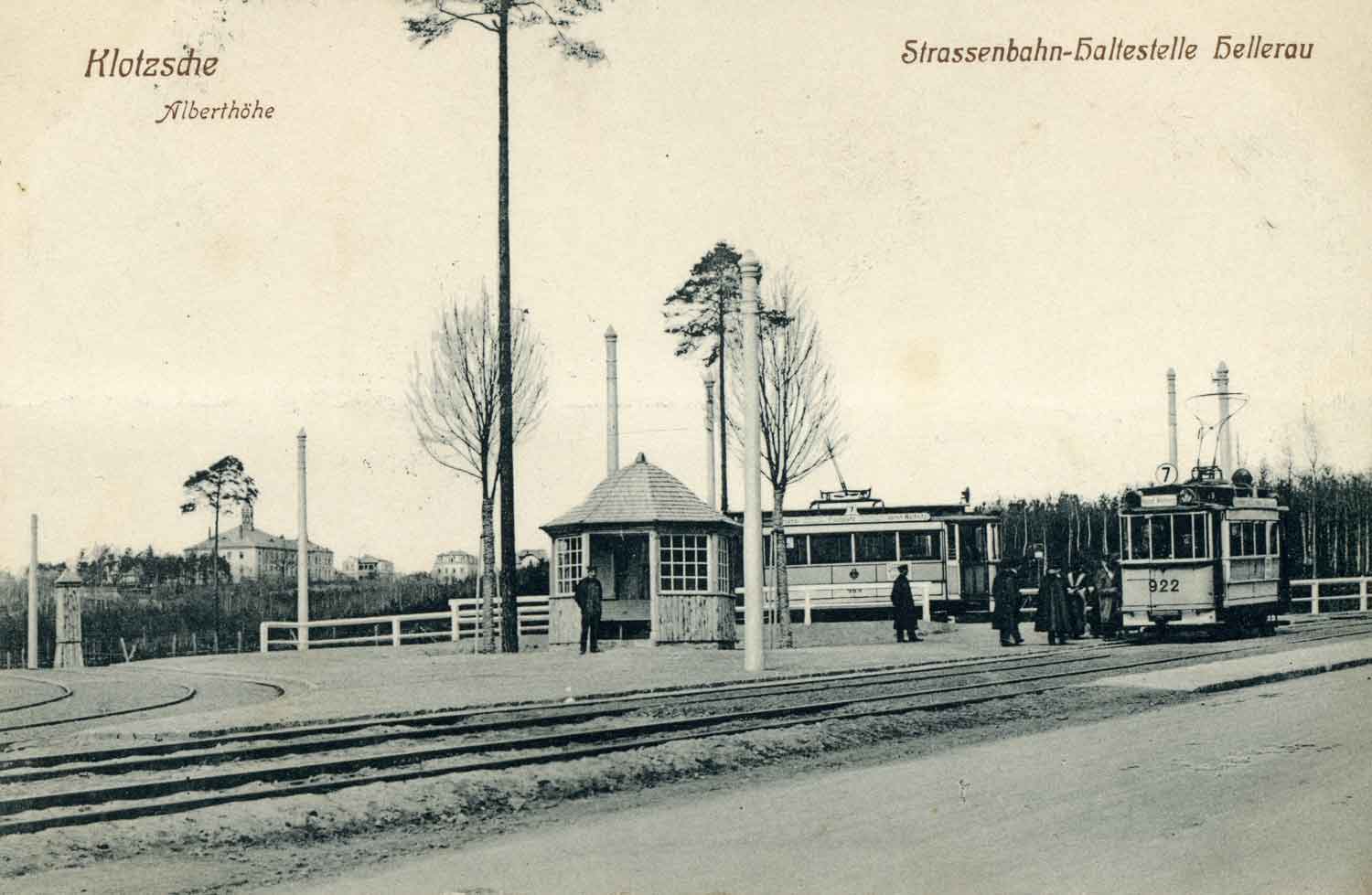Development plan⎟ Development
After the success at the Dritte Deutsche Kunstgewerbeausstellung (Third German Arts and Crafts Exhibition), the Dresden furniture manufacturer Karl Schmidt decided to expand his factory in autumn 1906. Right from the beginning, he had the idea that a settlement should be built next to the factory in the style of a garden city. He found the perfect spot for it in Hellerau and commissioned the architect Richard Riemerschmid with the development plan. His design symbolically connects the factory complex to the residential buildings and communal facilities in the shape of a screw clamp, forming a green organism. The idea of the garden city came from the Englishman Ebenezer Howard. After the Deutsche Gartenstadtgesellschaft (German Garden City Society) was founded in 1902, the movement was also given a platform in Germany.

Tram stop, branch to Hellerau, shuttle car Hellerau-Klotzsche.
Private collection Mario Schatz.
Hellerau takes shape – the development plan by Richard Riemerschmid
The first plan for the construction of Hellerau was drawn up by the architect and artist Richard Riemerschmid on behalf of the Dresden furniture manufacturer Karl Schmidt. Riemerschmid belonged to the elite of German Jugendstil artists, had already developed new furniture for Schmidt, and had also worked with him in 1906 for the Dritte Deutsche Kunstgewerbeausstellung (Third German Arts and Crafts Exhibition) in Dresden. Schmidt and Riemerschmid captured the zeitgeist with their modern design and use of sustainable materials and enjoyed huge success at the exhibition. The previous production facility soon reached its limits in terms of space and Schmidt decided to expand his factory and move to a new location as early as autumn 1906. Right from the beginning, he had the idea that a settlement should be built next to the factory in the style of a garden city. He found a suitable place for it on sloping ground north of Dresden, by the Hellerwald forest between Rähnitz and Klotzsche.
Living and working in a green organism
In 1898, the Englishman Ebenezer Howard presented his idea of creating an independent network of living, working and leisure with a garden city in the countryside. After the Deutsche Gartenstadtgesellschaft (German Garden City Society) was founded in 1902, the movement was also given a platform in Germany. When Howard visited Hellerau in 1912, he liked it very much because it was “not a mere imitation of English garden cities”:
“In Hellerau, the effort to build homes for people close to where they work and to bring work close to where they live is clearly evident.” (from: Dresdner Anzeiger, 14.09.1912)
Riemerschmid’s development plan clearly illustrates this close interweaving of factory premises, residential buildings and community facilities into a green organism:
- the factory is the heart
- the roads and paths following the site are the veins
- the houses are the organs
- the gardens and parks’ greenery are the urban space’s supporting skeleton
The factory complex was to have the symbolic shape of a screw clamp. Two housing complexes were also planned, one in the east for building small cooperative homes and one in the west to build private country houses. Riemerschmid envisaged an area for welfare facilities on the hill. The idea of welfare and independent housing ownership played a significant role in his concept. In addition, the Festspielhaus (Festival Theatre) grounds gave Hellerau an artistic component that still makes it special today.
On 4 June 1908, the non-profit Gartenstadt Hellerau GmbH was founded and soon afterwards the Baugenossenschaft Hellerau eGmbH. The foundation stone for the factory and settlement was laid in 1909.
Hellerau gets a tram
As early as July 1907, Karl Schmidt applied for the extension of tram line 7 for Hellerau, which was located outside Dresden. After much persuasion, his application was approved in May 1908, but the new line was to continue along the outskirts of Hellerau to Klotzsche. Construction began in July 1910 and the inaugural journey took place as early as 21 December. The stop on Moritzburger Weg was closest to the garden city and was therefore given the name Hellerau as well as a tram shelter designed by Riemerschmid. At the end of November 1911, Karl Schmidt applied for the construction of a branch line directly to Hellerau, which could already be inaugurated on 14 March 1913. To this day it leads to the reversing loop in Rähnitz.
